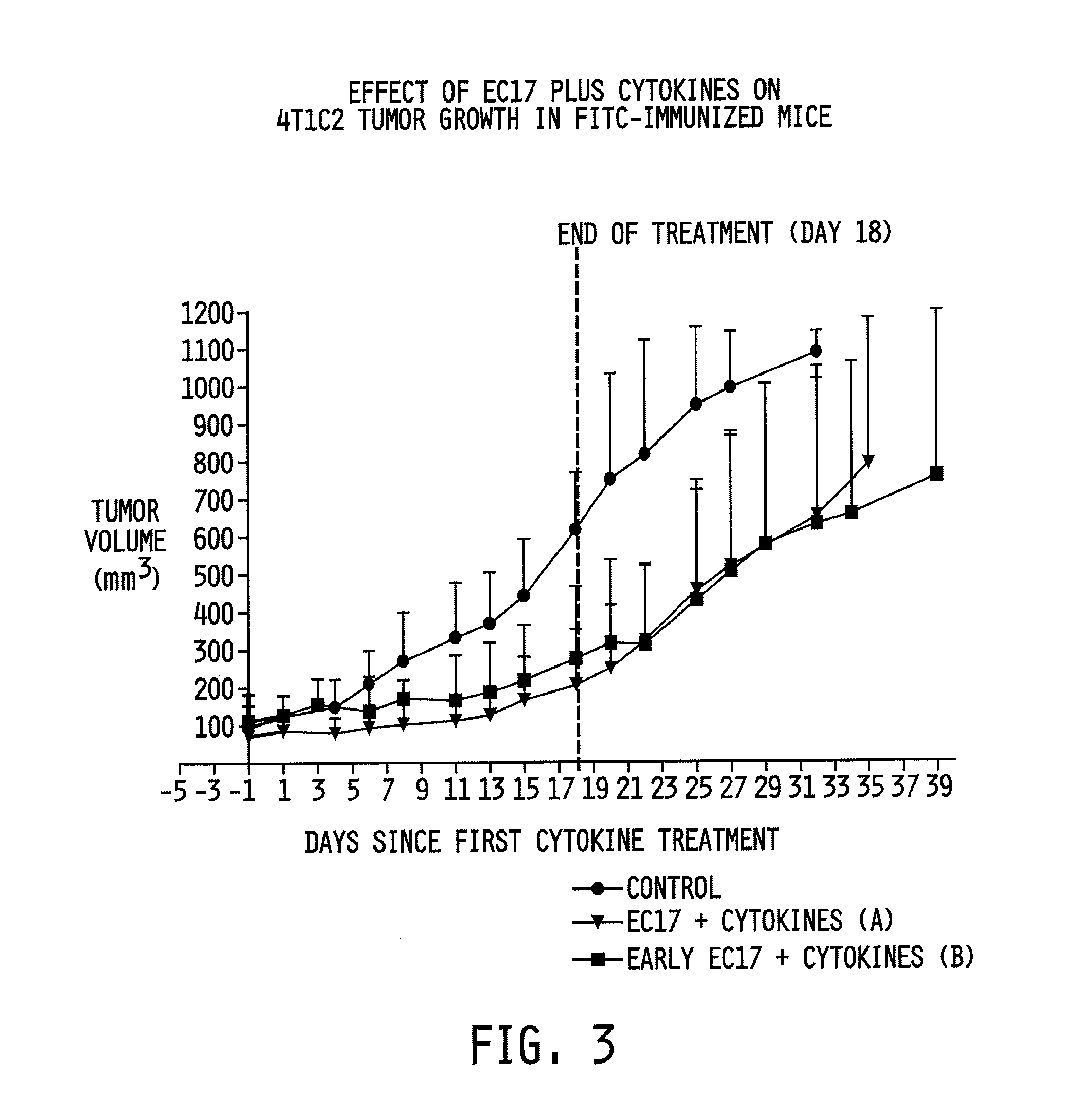Method of administering conjugates
a conjugate and conjugate technology, applied in the field of conjugate administration methods, can solve the problems of most, if not all, of the currently available chemotherapeutic agents and radiation therapy regimens having adverse side effects, and achieve the effects of reducing the number of cancer cells, preventing the formation of resistance to chemotherapeutic agents, and avoiding adverse side effects
- Summary
- Abstract
- Description
- Claims
- Application Information
AI Technical Summary
Benefits of technology
Problems solved by technology
Method used
Image
Examples
example 1
Temperature Analysis in Balb / C Mice
[0069]Female Balb / c mice were immunized 3 times at 1-week intervals against either 1 μg (FIG. 1) or 35 μg (FIG. 2) of EC90 (KLH-FITC; see FIG. 5) formulated with 100 μg GPI-0100. Bisfluorescein, was added to the EC17 (folate-FITC; see FIG. 4) composition (1500 nmol / kg EC17 plus 350 nmol / kg bisfluorescein). Bisfluorescein was added to enhance the allergenicity of the composition. The mice were intravenously challenged with 1500 nmol / kg EC17 plus 350 nmol / kg bisfluorescein. The mice were then monitored for any change in body temperature via a rectal probe to detect any apparent allergenicity.
Preparation of Injectates: The EC90 (KLH-FITC) / GPI-0100 solutions were made fresh prior to each vaccination to avoid micelle formation upon storage. The 1 μg EC90 / GPI-0100 injectate (FIG. 1) was prepared by mixing 0.01 mg / ml EC90 and 1 mg / ml GPI-0100 in PBS, at pH 7.4 (0.1 ml per dose provided 1 μg KLH-FITC and 100 μg GPI-0100). The 35 μg EC90 / GPI-0100 injectate ...
example 2
Effect of Ligand Conjugates on Tumor Volume for Mice with Breast Tumor Implants
[0070]Two regimens were tested. In the first regimen, six to eight-week old (˜20-22 grams) female Balb / c mice were immunized with fluorescein isothiocyanate (FITC)-labeled keyhole limpet hemocyanin (KLH; see FIG. 5) at 35 μg / dose using a saponin adjuvant (e.g., GPI-0100; 100 μg / dose) at days 1, 15, and 29. On day 23, each animal was injected with 2.5×105 4T1c2 cells (a breast tumor cell line). Cancer loci were then allowed to grow. From days 42-60, all animals were injected daily ((qd×5)3; days 42-46, 49-53, and 56-60) with either phosphate buffered saline (PBS) or 500 nmol / kg of FITC-conjugated to folic acid via a gamma carboxyl-linked ethylene diamine bridge (see FIG. 4). The animals were injected on the same days with 20,000 U / dose of recombinant human IL-2. The animals were injected (TIW)3 with IL-2 in the same weeks as the animals were injected with folate-FITC.
[0071]In the second regimen, six to eig...
example 3
Synthesis of KLH-FITC and Folate-FITC
[0073]Folate-FITC was synthesized and purified as described in Kennedy, et al. in Pharmaceutical Research, Vol. 20(5), 2003 and in WO2006 / 101845, each incorporated herein by reference. EC17 was stored as a frozen solution of 5.5 mg / ml in PBS, pH 7.4. EC90 (KLH-FITC) solid (83% protein content) had a labeling ratio of ˜129 μmol FITC per gram of KLH. The stock solution was made in PBS, pH 7.4 at 2.5 mg / ml and sterile filtered with a 0.22 μm syringe filter. KLH-FITC was synthesized using methods similar to those for folate-FITC.
PUM
| Property | Measurement | Unit |
|---|---|---|
| molecular weight | aaaaa | aaaaa |
| pH | aaaaa | aaaaa |
| volume | aaaaa | aaaaa |
Abstract
Description
Claims
Application Information
 Login to View More
Login to View More - R&D
- Intellectual Property
- Life Sciences
- Materials
- Tech Scout
- Unparalleled Data Quality
- Higher Quality Content
- 60% Fewer Hallucinations
Browse by: Latest US Patents, China's latest patents, Technical Efficacy Thesaurus, Application Domain, Technology Topic, Popular Technical Reports.
© 2025 PatSnap. All rights reserved.Legal|Privacy policy|Modern Slavery Act Transparency Statement|Sitemap|About US| Contact US: help@patsnap.com



